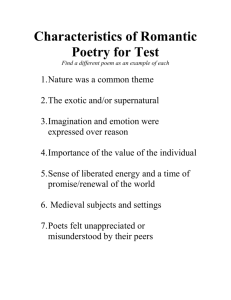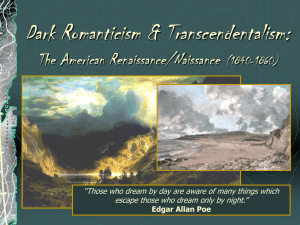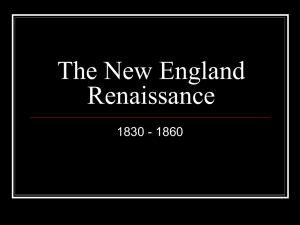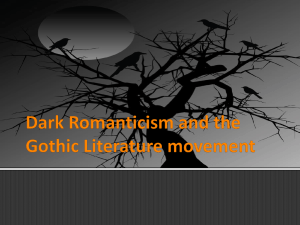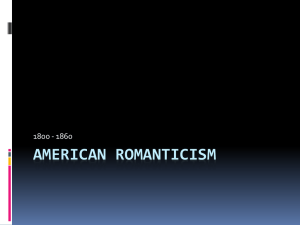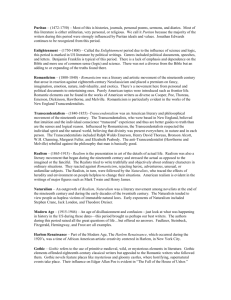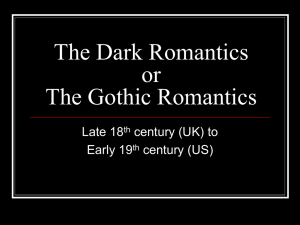American Romanticism
advertisement
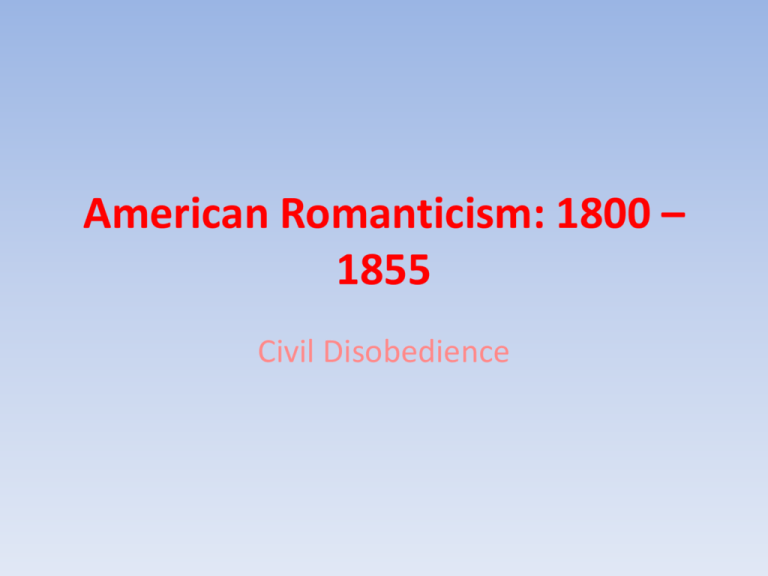
American Romanticism: 1800 – 1855 Civil Disobedience Unit Overview Students will … • investigate ways that members of American society have disagreed with the governing ideals • make comparisons among several texts that deal with civil disobedience and form their own claim • identify rhetorical elements in speeches, texts, and documents meant to persuade an audience. Unit Essential Question During the period of American Romanticism… How did American writers criticize and challenge early American thinking? Lesson Essential Questions How do critical readers look for truth? What relationships do you see in the text(s) presented? How does this work illustrate the society’s concept of independence? How does this work compare societal values? In what ways is the author criticizing his/her own society? Is his/her critique justified? What would be an effective way to incite public response to a current social problem? How can you tell if a source is credible? Vocabulary Literary Terms • Rhetorical Strategies • Logical Fallacy • Parallelism • Satire Transcendentalism Romanticism • Metonymy • Fireside poets Historical Concepts • Westward Expansion • Manifest Destiny • Industrial Revolution Social Reform • Nationalism • Sectionalism Characteristics of American Romanticism • Values feeling and intuition over reason • Places faith in inner experience and the power of the imagination • Shuns the artificiality of civilization and seeks unspoiled nature • Prefers youthful innocence to educated sophistication • Champions individual freedom and the worth of the individual • Contemplates nature’s beauty as a path to spiritual and moral development • Looks backward to the wisdom of the past and distrusts progress • Finds beauty and truth in exotic locals, the supernatural realm, and the inner world of the imagination • Sees poetry as the highest expression of the imagination • Finds inspiration in myth, legend, and folk culture Early Romantics • Romanticism is the period of American writing that is inspired by nature, emphasized by emotions and imagination, and celebrates the individual spirit. • How does this image reflect the characteristics of American Romanticism? Early Romantic Writers • William Cullen Bryant-celebrated as one of the first Romantic poets. • Washington Irving-pioneered the short story as a literary form. He wrote “The Devil and Tom Walker” and “The Legend of Sleepy Hollow.” • James Fenimore Cooper-credited with writing the first “truly” American novel. Inspired by westward expansion, period of exploration that led Americans out to the western wilderness. Known for his masterpiece The Last of the Mohicans. His novels were known as The Leatherstocking Tales. Quotes from the Romantic Age • “To him who in the love of Nature holds Communion with her visible forms, she speaks A various language; for his gayer hours She has a voice of gladness, and a smile And eloquence of beauty, and she glides Into his darker musings, with a mild And healing sympathy, that steals away Their sharpness, ere he is aware…” -From William Cullen Bryant’s “Thanatopsis” Assessment Prompt #1 • Compare/Contrast: How do the views of the Puritans differ with the concepts captured by the Romantics? The Fireside Poets A group of New England poets whose work was morally uplifting and romantically engaging. • Emphasized moral themes • Were viewed as equals of British poets • Stressed individualism and an appreciation of nature • Were committed to social reform The Fireside Poets • Henry Wadsworth Longfellow – best known of the group; stressed individualism and an appreciation of nature The following poets were known for using their poetry to bring social reform, or changes in society, such as abolition, women’s rights, temperance, and factory worker’s rights. • James Russell Lowell • Oliver Wendell Holmes • John Greenleaf Whittier Assessment Prompt #2 • Analyze: In what sense did each member of the Fireside Poets attempt to improve the United States? The Transcendentalists A group of writers, led by Ralph Waldo Emerson, who practiced transcendentalism(a philosophical and literary movement that emphasized living a simple life and celebrating the truth found in nature and in personal emotion and imagination. Characteristics of the Transcendentalists • • • • Emphasized living a simple life Stressed a close relationship to nature Celebrated emotions and the imagination Stressed individualism and self-reliance(a key term) • Believed intuition(inner perception) can lead to knowledge • Believed in the inherent goodness of people • Encouraged spiritual well-being over financial well-being Comic View • How does the argument between Calvin and Hobbes reflect the beliefs of the Transcendentalists? Famous Transcendentalists • Ralph Waldo Emerson • Henry David Thoreau • These would influence later writers, such as – Walt Whitman – Robert Frost – Wallace Stevens Famous Quotes • Henry David Thoreau once stated, “Go confidently in the direction of your dreams! Live the life you’ve imagined. As you simplify your life, the laws of the universe will be simpler.” Assessment Prompt #3 • Evaluate: Is Transcendentalism impractical or could it be practiced today? American Gothic A group of writers, who unlike most romantics, explored the capacity of human evil and whose work explored darker themes. Considered the “anti-transcendentalists” Characteristics of American Gothic • • • • • • Known as the “Brooding Romantics” Did not believe in the innate goodness of people Explored the human capacity for evil Probed the inner life of characters Explored characters’ motivations Agreed with romantic emphasis on emotion, nature, and the individual • Included elements of fantasy and the supernatural in works Gothic Elements • • • • • Grotesque characters Bizarre situations Violent events Began in Europe Inspired by he gothic architecture of the Middle Ages Gothic Writers These writers were inspired by Washington Irving. Irving, unlike the official “brooding Romantics” wanted to keep “mankind in good humor with one another.” • Edgar Allan Poe-consider the father of American Gothic literature; his plots involve physical and mental torture, and retribution from beyond the grave. • Nathaniel Hawthorne-famous for The Scarlet Letter, which focuses on the psychological effects of sin and guilt • Herman Melville-blended adventure stories and exploration with issues of madness and the conflict of good versus evil Assessment Prompt #4 • What aspects of gothic literature appear to have been influenced by gothic architecture?

